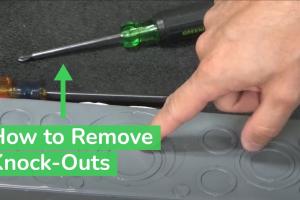Mastering Electrical Work: The Ultimate Guide to Removing Knockouts from Electrical Boxes

-
Quick Links:
- Introduction
- Understanding Knockouts
- Tools Required
- Step-by-Step Guide to Remove a Knockout
- Safety First
- Common Mistakes to Avoid
- Case Studies
- Expert Insights
- Conclusion
- FAQs
Introduction
Removing a knockout from an electrical box might seem daunting, but with the right tools and techniques, it can be a straightforward task. In this comprehensive guide, we will walk you through everything you need to know about knockouts, why they are essential, and how to remove them safely and effectively.
Understanding Knockouts
Knockouts are pre-scored sections in electrical boxes designed to allow entry for wiring. They come in various sizes and can be found in different types of electrical boxes. Understanding their function helps in ensuring you make a clean and safe removal.
- Purpose: To provide access for electrical wiring.
- Types: Metal and plastic electrical boxes.
- Sizes: Varies based on the box design and application.
Tools Required
Before you begin, gather the following tools:
- Flathead screwdriver
- Pliers
- Knockout punch set (optional)
- Safety goggles
- Wire cutters/strippers
- Electrical tape
Step-by-Step Guide to Remove a Knockout
Follow these steps to remove a knockout from an electrical box:
Step 1: Turn Off the Power
Always ensure the power is turned off at the circuit breaker before starting any electrical work to prevent accidents.
Step 2: Identify the Knockout
Examine the electrical box to locate the knockout you wish to remove. Check the size required for your wiring needs.
Step 3: Use Tools for Removal
For plastic knockouts, gently tap around the edges with a screwdriver to loosen. For metal knockouts, use a pair of pliers or a knockout punch for a clean removal.
Step 4: Clean the Edges
Ensure the edges of the knockout hole are smooth to avoid damaging wires or creating hazards.
Step 5: Insert the Wiring
Feed your electrical wiring through the newly created hole and secure it with a clamp to ensure safety and stability.
Safety First
Electrical work can be hazardous. Always prioritize safety:
- Wear safety goggles to protect your eyes.
- Use insulated tools when working with electricity.
- Double-check that the power is off before beginning work.
- Keep your workspace organized to avoid accidents.
Common Mistakes to Avoid
Here are some common pitfalls when removing knockouts:
- Not turning off the power.
- Using excessive force which can damage the box.
- Failing to clean the edges properly.
- Not securing wires adequately after installation.
Case Studies
In various home improvement projects, the proper removal of knockouts has led to successful electrical installations. For example, a homeowner in California faced issues with improper wiring due to unremoved knockouts leading to short circuits. By following the steps above, they successfully upgraded their electrical system without professional help.
Expert Insights
Electrical experts emphasize the importance of understanding your electrical box layout before proceeding with any modifications. "Always know what you're working with," advises John Doe, a licensed electrician with over 20 years of experience. "A small oversight can lead to major issues down the line."
Conclusion
Removing a knockout from an electrical box is a manageable task when approached with the right knowledge and tools. By following this guide, you can ensure a safe and effective installation, contributing to better electrical management in your home.
FAQs
1. What is a knockout in an electrical box?
A knockout is a pre-scored section of an electrical box designed to allow easy access for wiring.
2. Can I remove a knockout without special tools?
Yes, a flathead screwdriver and pliers are sufficient for most knockouts.
3. Is it safe to work on electrical boxes?
As long as you turn off the power and follow safety guidelines, it can be safe.
4. How do I know which knockout to remove?
Choose the knockout based on your wiring needs and layout of your electrical system.
5. What if I damage the knockout?
Ensure edges are smooth and secure. If significant damage occurs, consider replacing the box.
6. Should I hire a professional?
If you're unsure about electrical work, consulting a licensed electrician is advisable.
7. Can I remove multiple knockouts?
Yes, but ensure to manage the wiring appropriately and maintain safety.
8. What size knockout do I need for my wires?
Refer to the wiring specifications; typically, knockouts come in standard sizes suitable for most applications.
9. How can I ensure my installation is safe?
Adhere to electrical codes, secure wiring properly, and double-check connections.
10. Are there any regulations about knockouts?
Yes, it's important to follow local electrical codes and regulations when working with electrical systems.
Random Reads
- The ultimate guide to deleting devices from your spotify account
- How to re fuse a power supply
- How to restore deleted contacts on android
- How to restore sun damaged plastic
- Quickly create folders android
- Quick ways to log in as administrator windows 10
- How to make sims 4 run faster
- How to make sims inspired in the sims 4
- Test webcam
- The best fruits in blox fruit ranked